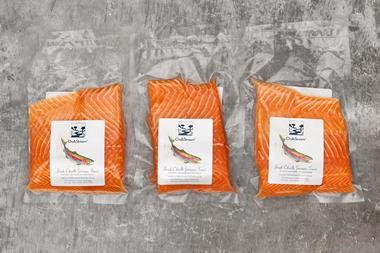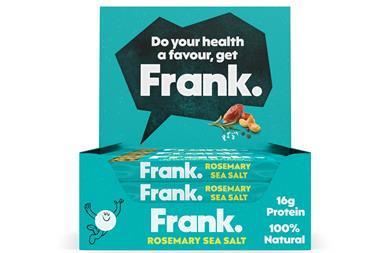The quest for the ultimate sales-conducive environment is intensifying. Gone are the disastrous experiments with crooked gondolas introduced a few years back "to make life more interesting". Today's supermarkets are warm, calm and more homely places with strong, clear lines and wide aisles. Category fixtures are designed to suit the product, with the real interest concentrated on life-style categories such as beers, wines and spirits and snacking, where the multiples are increasingly working with category captains to tap in to consumer trends.
The new generation of store design also offers flexibility because what looks great today will tire more quickly than ever. Marks and Spencer once designed its fittings to last for 100 years, but now everything in its new Simply Food convenience format is moveable. Even 20% of the refrigeration can be shifted with minimum fuss and the in-store bakery is an integral unit that only needs to be plugged in.
The look and feel of the store is changed on an hourly basis by remerchandising to match the time of day.In winter the lighting is altered to communicate a cosy feel through the glazed store front and there is hot coffee and rotisserie, while in summer it creates a cool, refreshing feel and there is plenty of fresh produce and chilled wine.
Store design today is about much more than a lick of paint and a few new floor tiles. The supermarkets have woken up to the fact they need to improve the shopping experience as a whole if they are to retain customers and encourage them to spend more in high margin categories. As John Ryan, head of communications at design agency 20:20, says: "The supermarket will never be anything more than a distress purchase. But if you can make it so that people don't heave a sigh when they walk in the door, you've come quite a long way. And improving the shopping experience is not only about getting customers in and out more quickly."
As a result the multiples have replaced their uniform take on design with a varied approach based on local demographics at the most basic level and consumer segmentation from loyalty card data at the next. "We begin with the store format and the proposition of that format," says Sainsbury's formats and in-store manager Richard Cristofoli. "The role of design is to dramatise that proposition and bring it to life, focusing on the areas we want to drive and the key areas of differentiation. The design needs to be customer benefit driven so the lighting and display of products must be complementary to the proposition, not just design for design sake."
He adds: "Five years ago designers would finish one bit and then look around for the next thing to tackle it was very much a retailers' agenda. Now we ask where we can make a difference and where customers say it would make a difference. Today it's about a consumer agenda."
New concepts can be seen in fruit and veg. Safeway is experimenting with bold striped ski-slopes of vertically-stacked, loose, produce as a way to articulate freshness and abundance. In health and beauty, Asda has teamed up with L'Oréal and Coutts Retail Communications to develop a solution that changes the merchandising, lighting and racking, and introduces new premium and cosmetic ranges.
In serve-over, chains including Tesco and Sainsbury are experimenting by putting this most obvious articulation of their fresh food and quality position in the middle of the store.
Work is also underway in updating refrigeration. Supermarkets are still underfooted in chilled fixtures and engineers are sinking the mechanics beneath the floor or on satellites away from the actual units in order to increase shelf space. Where units were typically base shelf, plus four, a couple of years ago, they are now base, plus five. Base, plus seven is on the agenda. Refrigeration is being introduced throughout the store to support the product offer, improve the look of the store and encourage impulse buys in the aisles and at the checkout.
But the overall message that Tesco, in particular, has sent to its shoppers is not great, according to critics who say the stop-start approach to its store upgrade programme has left too many customers feeling disappointed with their shopping experience.
The point is not lost on Tesco's head of UK design Jeremy Lindley. "We now have a programme called refresh my superstore' which we are rolling out to 100 stores a year to upgrade the look, equipment and offer. Everything needs to be bright and clean for the shopper to feel we care. We've missed that in the past and, historically, we've been criticised for allowing quite a few of our stores to appear very tired."
Putting the consumer first means the concept of the flagship store being miles or years in front of the rest of the battalion is old hat. "I always wonder quite what message that sends to people outside the areas where these stores are," says Sainsbury's Cristofoli.
This view will not sit well with progressive Safeway, which has pushed its traditional boundaries with new concepts like The Hub and Megafresh at its Plymstock hypermarket. Its director of format and merchandising Grant Henley has a pile of letters from impressed shoppers at its Woking store. "At one level the store is simply more productive because the space works much harder," he insists. Shelving units have been redesigned to eliminate airspace and maximise stock units. They have also been tilted to display the product more effectively and vertical blocking of product creates eye-catching visuals.
"We've been much braver than we have in the past and have concentrated on developing the store as a whole rather than as a collection of individual, beautiful parts. That means we have a basic set of principles that can be tailored individually for each store."
But the new generation store is not only about inspired, consumer focused design initiatives. In-store theatre adding value as well as making the experience more pleasurable and an improved shopping experience must also involve customer and staff interaction. And there is an increasing variety around the store, from Tesco's wine advisors, to Asda staff trained by L'Oréal to offer more useful help and advice in the health and beauty category, and in-store chefs who offer genuine culinary experiences to order.
Safeway puts its entire Woking staff through a new theatrical training course and Henley believes the customer interaction is totally different as a result. "Simply bunging a pizza in an oven is not enough," he says. "It's all about getting the right people and allowing them to enjoy what they do. On our food to go counters, chefs wear voice amplifiers so they can chat to customers about the food they're preparing. There's a lot of banter and a real hubbub about the place that brings the store and the fresh food offer to life."
The stats appear to bear out Henley's enthusiasm. Safeway has now revamped 73 stores about 15% of its total sales area and fully refitted stores have generated sales growth of 13% as well as improved gross margins.
Nobody today can afford to overlook the value of store design. But it cannot work in isolation and as Tesco's Lindley notes, if you're putting all the work in and not selling more, something is wrong. And while Sainsbury's Cristofoli believes a genuine step change in design has an impact, the range still needs to be right, available and priced correctly. "That's why I talk about dramatising the proposition. Design brings out the qualities of what is inherently there."
{{COVER FEATURE }}
Close menu
- Home
- Retail & Wholesale
-
Products & Suppliers
- Back to parent navigation item
- Products & Suppliers
-
Product Categories:
- Back to parent navigation item
- Product Categories:
- Alcoholic drinks
- Bakery
- Cereals & breakfast
- Cheese
- Chicken & poultry
- Chocolate
- Confectionery
- Crisps, nuts & snacks
- Dairy
- Fish
- Fresh produce
- Frozen
- Household
- Meat
- Own Label
- Sauces & condiments
- Seasonal
- Soft drinks
- Vaping
- Vegan & plant-based
- World foods
- Suppliers
- People
- Reports & Data
-
Topics A-Z
- Back to parent navigation item
- Topics A-Z
-
Popular topics:
- Back to parent navigation item
- Popular topics:
- Cost of living crisis
- Crime
- Deposit Return Schemes
- Finance
- Government & Regulation
- Health
- Inflation
- Loyalty
- Marketing
- Mergers & Acquisitions
- New Product Development
- Sourcing
- Supply chain
- Sustainability & environment
- Technology
- Ultra Processed Foods
- Vaping
- A-Z all topics
- Content by type:
- Events
- Ask iA (beta)
- Subscribe now
Sign in to comment on this article
Not logged in before? Register for FREE guest access today.
You will be able to:
- Read more stories
- Receive daily newsletters
- Comment on stories
Advert















No comments yet